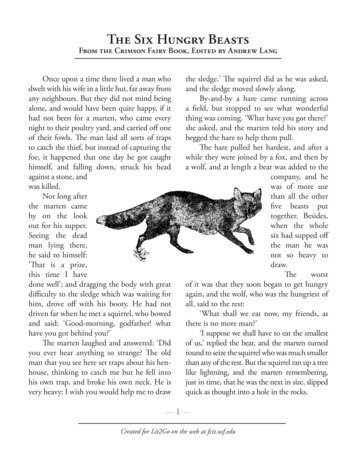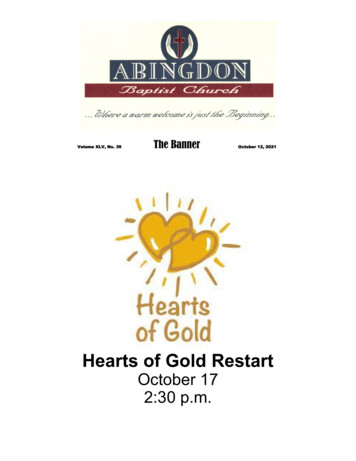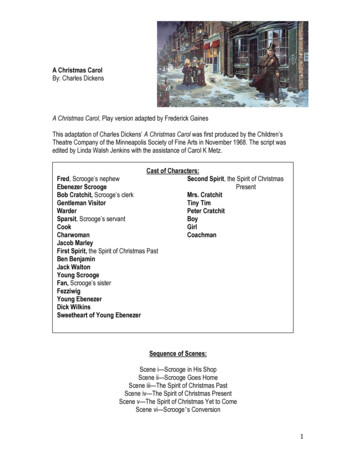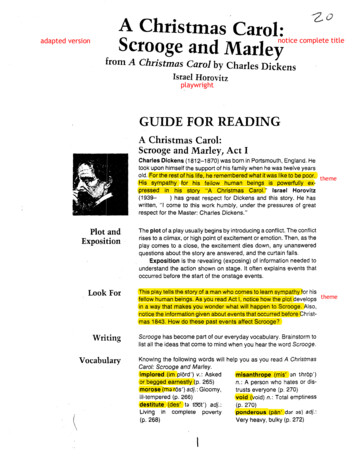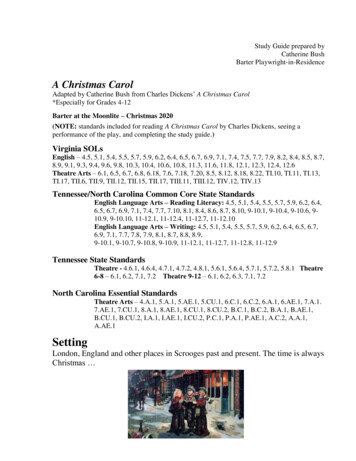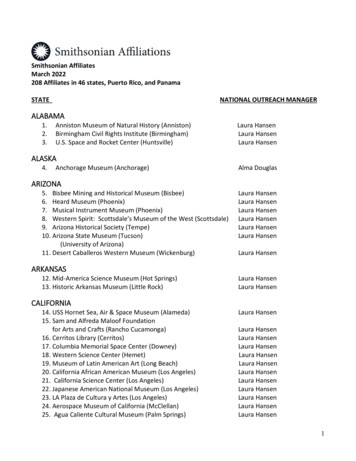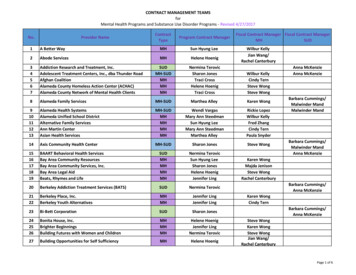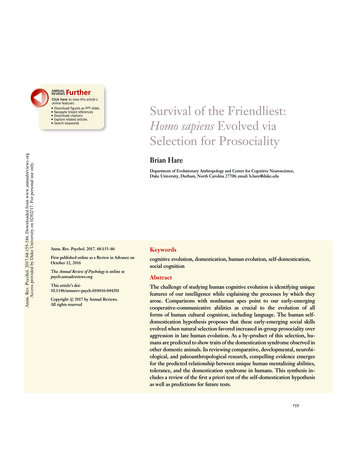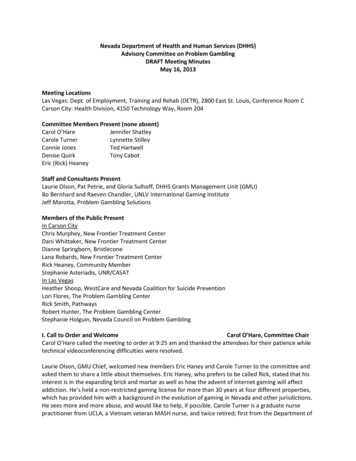
Transcription
Nevada Department of Health and Human Services (DHHS)Advisory Committee on Problem GamblingDRAFT Meeting MinutesMay 16, 2013Meeting LocationsLas Vegas: Dept. of Employment, Training and Rehab (DETR), 2800 East St. Louis, Conference Room CCarson City: Health Division, 4150 Technology Way, Room 204Committee Members Present (none absent)Carol O’HareJennifer ShatleyCarole TurnerLynnette StilleyConnie JonesTed HartwellDenise QuirkTony CabotEric (Rick) HeaneyStaff and Consultants PresentLaurie Olson, Pat Petrie, and Gloria Sulhoff, DHHS Grants Management Unit (GMU)Bo Bernhard and Raeven Chandler, UNLV International Gaming InstituteJeff Marotta, Problem Gambling SolutionsMembers of the Public PresentIn Carson CityChris Murphey, New Frontier Treatment CenterDani Whittaker, New Frontier Treatment CenterDianne Springborn, BristleconeLana Robards, New Frontier Treatment CenterRick Heaney, Community MemberStephanie Asteriadis, UNR/CASATIn Las VegasHeather Shoop, WestCare and Nevada Coalition for Suicide PreventionLori Flores, The Problem Gambling CenterRick Smith, PathwaysRobert Hunter, The Problem Gambling CenterStephanie Holguin, Nevada Council on Problem GamblingI. Call to Order and WelcomeCarol O’Hare, Committee ChairCarol O’Hare called the meeting to order at 9:25 am and thanked the attendees for their patience whiletechnical videoconferencing difficulties were resolved.Laurie Olson, GMU Chief, welcomed new members Eric Haney and Carole Turner to the committee andasked them to share a little about themselves. Eric Haney, who prefers to be called Rick, stated that hisinterest is in the expanding brick and mortar as well as how the advent of internet gaming will affectaddiction. He’s held a non-restricted gaming license for more than 30 years at four different properties,which has provided him with a background in the evolution of gaming in Nevada and other jurisdictions.He sees more and more abuse, and would like to help, if possible. Carole Turner is a graduate nursepractitioner from UCLA, a Vietnam veteran MASH nurse, and twice retired; first from the Department of
ACPG Meeting 5-16-13DRAFT MinutesPage 2 of 5Veteran Affairs, and most recently as the Deputy Director for Veteran Services, State of Nevada. Herinterest on the committee is based on her background and expertise in veteran’s health issues.II. Public CommentDr. Bo Bernhard spoke about the upcoming global gaming conference. Held every three years, theconference has just been approved in Nevada for CTEs for marriage and family counselors. He isexpecting 425 attendees.III. Approval of MinutesCarol O’Hare Connie Jones moved to approve the minutes of the February 21, 2013 ACPG meeting assubmitted. The motion was seconded by Tony Cabot and carried unopposed with noabstentions.IV. OverviewLaurie Olson, Chief, GMUStatus of Funding. Ms. Olson stated that the funding has not changed since the RFA was published. Perthe Advisory Committee’s recommendation, 900,000 has been allocated for treatment programs, withan additional 25,000 for workforce development within treatment programs; 250,000 for preventionprograms; and 50,000 for workforce development outside of treatment programs. There is also a smallreserve, as is customary.Applications and Scores. Five Treatment proposals were submitted, all from current grantees:Bristlecone, New Frontier, Pathways, Reno Problem Gambling Center, and The Problem GamblingCenter. The proposals were reviewed and scored by experts from outside Nevada, and the scoringresults were tabulated in a spreadsheet which was provided as a handout. Total funding requests fortreatment in year one exceed available funding by 54,660. The workforce development piece withintreatment is under by 5,576. In year two, treatment funding requests versus available funding is evenhigher, while workforce development remains the same.In the area of Prevention, proposals were received from Nevada Council on Problem Gambling (NCPG)and University of Nevada - Reno (UNR). Both received scores in the high 70s. Requests exceed availablefunds by 3,779 in the first year and 18,866 in year two.NCPG was the only applicant in the area of Workforce Development. The funding request for year oneleaves 220 on the table; in year two it zeros out. The Prevention and Workforce Developmentapplications were reviewed by GMU staff, Dr. Marotta and one reviewer from outside the state with noknowledge of the applicants, in order to provide an objective review.Award Recommendation Process. Ms. Olson recapped the award recommendation processes fromprevious years. Three years ago there were many more applicants than now. The ACPG reviewed theproposals and made specific funding recommendations, and it was very difficult to make the dollarswork. Last year a slightly different approach was taken; the applications were reviewed by outsideexperts, but the ACPG again tried to recommend specific dollar amounts, which was a difficult process.In the end, the committee decided to fund the applicants at their mid-year reallocation levels. Ms. Olsonsuggested, if amenable, that the ACPG focus on the content of the proposals and formulaterecommendations as to which programs to fund, but turn over the money piece to staff. She asked JeffMarotta to share some process strategies that can be used for determining grant awards.
ACPG Meeting 5-16-13DRAFT MinutesPage 3 of 5Dr. Marotta explained his background as a technical consultant for problem gambling with the State ofNevada and described the typical government grant procurement process, which differs from that of theprivate sector. Once it has been established that the applicant’s request is well founded, they know theirprogram and capabilities, and the math works out, there are three principals that can be use in decidinghow to distribute limited funds: need, capacity and performance.In response to a question from Mr. Cabot, Ms. Olson clarified that the committee’s recommendationswould cover a two-year grant period. Treatment providers were not required to submit budgets, only anestimate of what they will need based on the fee-for-service schedule. Regardless of the amount of theirrequests and what is decided, the treatment strategic plan requires a mid-year funding reallocationbased on performance during the first six months of the year, which helps ensure no unused money isleft on the table and clients are served. The prevention and workforce development proposals didrequire budgets, and whatever is decided by the committee and/or staff will remain in place throughoutthe two-year funding period. Ms. Olson added that the applicants are allowed to make changes to theirproposals in response to questions from the committee, which then becomes their scope of work. If thecommittee believes something should be changed or added, or has concerns regarding fiscal or programissues, it can request more focused or more frequent fiscal or program monitoring as a condition of thegrant.Ms. Turner asked for clarification between the roles of the Department and the ACPG. Ms. Olsonexplained that DHHS is the State department that oversees the Fund for the Treatment and Preventionof Problem Gambling, which has been assigned to the GMU in the Director’s Office. The GMU issues andmonitors grants, and pays draws. The ACPG is a statutory body charged with advising the department onhow to address problem gambling in Nevada. The ACPG makes recommendations to DHHS DirectorMike Willden, who makes all final decisions. The Department relies on the expertise of ACPG membersto help develop the treatment and prevention strategic plans, and how to allocate funding between thethree program areas.Ms. O’Hare stated she was comfortable letting the department determine specific monetary awardsbased on the recommendations of the committee, and asked for input from the committee. As therewere no other opinions offered, consensus was implied.Conflict of Interest. ACPG members were asked to disclose whether they serve on the governing boardor have other affiliations, including volunteer, employment or contract work, with any of the applicantorganizations. According to the bylaws, a conflict exists if an ACPG member were to gain financially if anorganization is funded. In the past, members serving on a board have been allowed to participate indiscussions, but have excused themselves from the vote.ACPG MemberTreatment ProposalsPrevention ProposalsWorkforce DevelopmentProposalsCarol O’HareNo conflictApplicant, no vote ordiscussion (NCPG)Applicant, no vote ordiscussion (NCPG)Carole TurnerNo conflictNo conflictNo conflictConnie JonesBoard member of applicant,no vote (The PGC)Board member ofapplicant, no vote (NCPG)Board member ofapplicant, no vote (NCPG)
ACPG Meeting 5-16-13DRAFT MinutesPage 4 of 5ACPG MemberTreatment ProposalsPrevention ProposalsWorkforce DevelopmentProposalsDenise QuirkApplicant, no vote ordiscussion (Reno PGC)Board member ofapplicant, no vote (NCPG)Board member ofapplicant, no vote (NCPG)Eric HeaneyNo conflictNo conflictNo conflictJennifer ShatleyNo conflictBoard member ofapplicant, no vote (NCPG)Board member ofapplicant, no vote (NCPG)Lynn StilleyApplicant, no vote ordiscussion (Pathways)No conflictNo conflictTed HartwellNo conflictNo conflictNo conflictTony CabotNo conflictBoard member ofapplicant, no vote (NCPG)Board member ofapplicant, no vote (NCPG)V. and VI. Review of Proposals and Award RecommendationsCarol O’HareEach applicant was given three minutes to comment on their application before being questioned by thecommittee. The committee began with the Treatment applications, which included Bristlecone, NewFrontier Treatment Center, The Problem Gambling Center, Reno Problem Gambling Center, andPathways Counseling.In response to an earlier question from Ms. Turner, Dr. Bernhard stated that the most recent figuresindicate that 12% of those receiving treatment through the State of Nevada Problem Gambling Fund arevets or active military. He added that two years ago it was 8.1%, but emphasized it doesn’t necessarilyindicate an actual increase.The committee discussed each of the treatment applications and the 54,660 shortage between therequests and available funding. Ms. Olson explained that reserve funds are primarily used to providecash flow when bills first start coming in from the grantees, prior to receiving payments from therevenue source, but the reserve also serves as a cushion in the event revenue comes in less thanpredicted. She stated that grant awards cannot be issued for more money than the Department has theauthority to spend, and once an amount is awarded, it can’t be increased later. Also, there are nocarryover funds from year to year. If for some reason a significant amount was left on the table at theend of the year, the Department would probably take a work program to the interim finance committeeto increase its authority for the second year. That’s the only way funds can be carried over to the nextfiscal year. As far as mid-year reallocations, there will be four during this two-year grant period: in thebeginning of FY14, in mid-FY14, again when the FY15 awards are issued, and midway through FY15.Ms. O’Hare called for a motion to recommend that the Department fund all five treatment proposals tothe extent possible with the funding available. Ted Hartwell made a motion to recommend funding Bristlecone, Reno Problem GamblingCenter, New Frontier, and Pathways to the fullest extent possible. The motion was seconded byJennifer Shatley, and there being no further discussion, the motion carried unopposed with LynnStilley and Denise Quirk abstaining.
ACPG Meeting 5-16-13DRAFT MinutesPage 5 of 5 Tony Cabot motioned to recommend funding The Problem Gambling Center to the fullest extentpossible. Carole Turner seconded the motion, and there being no further discussion, the motioncarried unopposed with Connie Jones abstaining.Moving on to the remaining grant program areas, Ms. O’Hare ceded the gavel to Vice-Chair DeniseQuirk. At Ms. Quirk’s request, Dr. Marotta shared some history on the development of the Treatmentand Prevention Strategic Plans, and how they differ.Prevention ApplicationsThe committee heard presentations from Nevada Council on Problem Gambling (NCPG) and UNR,CASAT. Following a question and answer period with each of the applicants, the committee discussedthe disparity between the amount of funding requested and what was available for the two preventionprojects. Ms. Asteriadis was questioned regarding the higher request for year two. Mr. Hartwell askedthat the Department work with the applicant to review the budgets. Carole Turner moved to recommend funding the CASAT proposal at a level not to exceed theirrequest. Staff is to reevaluate the budget and work with the applicant to possibly reduce it. Themotion was seconded and carried unopposed with no abstentions. Ted Hartwell moved to recommend funding NCPG’s proposal after adjusting the budget ifnecessary to ensure funds are not over obligated. The motion was seconded by Lynn Stilley andcarried unopposed with Carol O’Hare, Connie Jones, Denise Quirk, Jennifer Shatley, and TobyCabot abstaining.Workforce Development ApplicationsThe Nevada Council on Problem Gambling (NCPG)was the only applicant in this area. After a briefpresentation and question and answer period, a recommendation was presented. Ted Hartwell moved to fund NCPG’s request for Workforce Development. The motion wasseconded by Lynn Stilley and carried unopposed, with Carol O’Hare, Connie Jones, Denise Quirk,Jennifer Shatley, and Toby Cabot abstaining.Ms. Quirk turned the meeting back to Ms. O’Hare, who called for public comment.VII. Public Comment.Ms. Springborn asked when the providers might expect to hear back on the funding award. Ms. Olsonreplied that she and Pat Petrie would work on it as quickly as possible and hoped to have the finalnumbers available by June.VIII. AdjournmentMs. O’Hare announced the date of the next meeting as August 15, and thanked everyone for theirparticipation. Connie Jones made a motion to adjourn the meeting. The motion was seconded by JenniferShatley and the meeting adjourned 12:43 pm.
Bristlecone, New Frontier, Pathways, Reno Problem Gambling Center, and The Problem Gambling Center. The proposals were reviewed and scored by experts from outside Nevada, and the scoring results were tabulated in a spreadsheet which was provided as a handout. Total funding requests for treatment in year one exceed available funding by 54,660.



